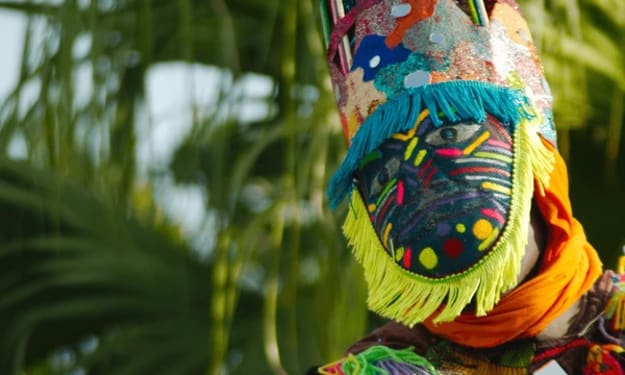A Celebration in Cosgrove
A hundred years after calamity, a community finds a new hope.

In a dusty town square nestled among the western mountains of the former Divided States of America, a low table is set and spread with a meal larger than any of the assembled locals have ever seen. A sacrifice is being made and a child approaches the platters of rat filet with wild leeks, stunted corn dripping with dog butter, and grainy porridge swimming with berries. As the child sits at the small chair, a nearby elder grips a carving knife in anticipation.
Technology had been outpacing human consciousness and capacity to comprehend consequences for a long time before the war broke out. The first weapons deployed were electromagnetic, and the sudden lack of electricity drew people away from their comfortable existences and virtual worlds, so many were outside when the nukes and incendiary holocaust bombs arrived. Whether this was the deliberate work of madmen in power or some automated system’s failsafes failing would never be known, but Why? was an irrelevant question. Dinosaurs slogging through ash under black skies might have asked Why? but following catastrophes of such magnitude, answers are rarely forthcoming and would provide no succor to the suffering if they were.
The people of Cosgrove, a mining community at the end of a highway snakeing through the mountains, had sustained through the decade-long nuclear winter by relocating to the mines. By the time they emerged, Why? mattered not one whit compared to What do we do now? Formerly complacent people, addicted to lives facilitated by machines, found themselves changed after years of huddling in the darkness eating their dead, and while the regular appearance of the sun again brought new hope, emergent problems had become evident.
Even during the worst of times, human instinct is indomitable, and the genetic impetus to preserve the species may be stronger during crises, but this most basic of human impulses was threatened by terrible radiation-induced birth defects. For the first half-century following the war, less than one-in-five babies born were viable. Stillbirths taken straight to the grave were seen as a blessing, absolving attendants of the need to take newborns with inside parts on the outside or who emerged looking like lasagna and placing them on the mountainside to let nature take its course. Most women died during childbirth and were buried in a special place for martyrs.
Babies who seemed healthy and physically equipped enough to become productive members of the community were allowed to live, and so the post-war generations were comprised of those with vestigial extra limbs, facial deformations, and often malformed sexual organs. Subsistence gathering and the hunting of whatever small game survived the dark years kept the people fed, and though they survived, they did not thrive.
Gods are believed to be immortal, but will expire from terminal lack of faith, and so the deities of The Divided States were largely abandoned by a population that felt betrayed by those who had believed they were protected by divine agency. Harsh realities kill gods who don’t keep their word, and a century after the war, the old faiths had waned, though certain residue remained, such as the staid celebration and gift giving that was observed just after the winter solstice.
By the time of the hundredth anniversary of the war, the people of Cosgrove had forgotten what life was like before. Images in old books and magazines depicted lives that were impossible for them to comprehend, full of people whose health and wholeness made them seem like aliens to those who dared search for evidence of the past. Those people, impossibly their ancestors, hovered around glowing screens and transported themselves in fantastic vehicles whose methods of propulsion had been lost to time. Though the remnants and relics of that civilization rusted all around them, the Cosgrovians were disconnected from all but the most utilitarian of their leavings. Facing the failures of human ingenuity and infrastructure forces a reliance on nature, and though it may be with some reluctance, it is She who will provide until not just the last human takes its last breath, but beyond, to their successors and future inheritors of the Earth.
Record keeping had become sloppy in the hundred years following the war, but it was well agreed upon by the elders of Cosgrove that the centennial of the bombs appearance was nearing, and that anniversary coinciding with the summer solstice seemed significant enough to warrant some acknowledgement and ceremony. The approach of the new century seemed to be an opportunity for new beginnings, which are, of course, always the wages of new ways of doing things, and so talk began of how to best observe the occasion. The death of Elder John three days ahead of the date seemed to be both an omen and an opportunity.
Humans are good at two things, which are necessarily related. They excel at acquiring more than they need, but are equally adept at going without. Intertwined together with these tenets of humanity, especially when wound about with notions of faith, arises the concept of sacrifice and the idea that giving up something now will provide a reward in the future, as the cycle of having and having not has been repeated through human endeavor for thousands of years. The often cold and hungry people of Cosgrove understood this as well as anyone in history.
At noon on the day of the solstice, a hundred years after a calamity that had altered humanity’s trajectory, stealing from them their dreams of the stars, relegating them to Neolithic methods of living, the people of Cosgrove gathered at the town square in a circle around four children. The quartet represented the healthiest members of the community under the age of three. There was a boy, and a girl, and two of the third sex, which was both and neither, and had arisen in great numbers after the war. Each of the children bore a numeral, 1-4, in ash on their forehead. Nearby, waiting for the sun to reach its zenith, stood an elder with a ratskin bag containing four similarly inscribed stones.
This was a ritual that had been lost to tradition until one of the more literate members of the community had found a reference to it in an old anthropological text. That there was no direct cultural or genetic thread connecting anyone in Cosgrove to the originators of the method was irrelevant. It was a desperate thing done by desperate people during desperate times, and the town had quickly reached consensus that it must be done.
It was agreed that through oblation they would find deliverance, and gazing at the children, everyone’s thoughts were about sacrifices already made and sacrifices to come. For four generations they had made hard choices, selecting who will live and who must die based on analyses made within minutes of each birth. Will they be able to work? Will they be able to contribute? Will they consume more resources than they generate? These questions were asked quickly, always in the presence of a shrieking mother or bloody corpse. What was one more hard choice?
With the sun high in the sky, the church bell was sounded with a hammer. Having fallen from its dilapidated steeple decades before, it now hung from a wooden frame in the center of town and was rung by hand when deemed necessary, announcing meetings, births, and deaths with various numbers of gongs. It sounded only once on the day of the solstice. A number was drawn and child 3 was bid to step forward, before being hoisted aloft by an elder and walked to a lone, small chair set at a low table covered with the finest foods the community could muster.
The tang of leeks rose from atop a platter piled with rat meat, unctuous dog butter ran in slabs down small ears of multicolored corn, and berries left streaks like blood in a tureen of oaty porridge. Their own mouths watering, the assembled encouraged the child to eat, and as the morsels disappeared the people of Cosgrove hooted and applauded, certain in their hearts that this represented a new beginning.
The sounds of celebration ceased as an elder approached the child with a knife in hand. They held their breath as another neared with a platter. Long pork served as the meal’s entree, though it had not been tasted in Cosgrove for decades. Thanks were given all around to Elder John. There would be sacrifices, yes, but this plan, to elevate one of the children to the status of champion, by giving them a greater portion of resources, food, education, and training than they would normally be entitled to was deemed worth trying.
The elders would not live to see it, but two decades hence, the selected child, grown to adulthood, would be sent beyond the borders of the town to seek out others and whatever else they might find in the wider world.
About the Creator
J. Otis Haas
Space Case
Enjoyed the story? Support the Creator.
Subscribe for free to receive all their stories in your feed. You could also pledge your support or give them a one-off tip, letting them know you appreciate their work.






Comments
There are no comments for this story
Be the first to respond and start the conversation.